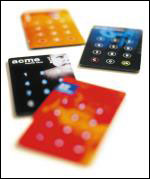Swedish technology startup Cypak has launched evaluation and development kits for its secure contactless technology that the company maintains can both complement and compete with more traditional RFID systems. Cypak joins its own small, chip-based designs with its methods for using conductive ink and adhesives to print electronic circuits and antennas on paper and plastic. The resulting contactless data-transfer technology can connect objects to host computers and networks at a fraction of the cost and power consumption of RFID, according to the company.
However, the company’s readers and tags are limited to read ranges of just 5 millimeters. Since some of its customers have asked for longer reader range, the company is developing a tag that complies with the ISO 15963 standard. The company plans to do this by mounting its ASIC (including microprocessor, large memory, clock, temperature and tamper sensors) onto an ISO 15963 antenna, which is longer than Cypak’s antenna and enables a greater read range. For close-up high-security applications using low-cost readers, Cypak will mount the ASIC onto its own proprietary antenna.
“The ISO 15963 will extend our offering to customers who want to use any of our patented functionality but would like to communicate with standard RFID readers for longer read range or to fit into a current RFID infrastructure,” says Stina Ehrensvärd, marketing director at Cypak, which is based in Stockholm. “ISO 15963 is integrated on our proprietary System-on-Chip (ASIC), that will be ready for mass production in Q3 2004.”
The company hopes the new kits will entice developers, systems integrators and business developers to use its technology for a range of potential applications.
“The best way to understand the potential of our technology is to see it working,” says Ehrensvärd. “Our long-term goal as a company is not to manufacture products but to provide our patented technology and license the rights to others to develop applications.”
Cypak’s has developed a technology to produce printable 13.56 MHz microelectronics tags and sensors that can detect if a package has been tampered with. The company is currently in the process of adding temperature sensors. The company has also developed low-cost readers that can be integrated into flat nonmetallic surfaces such as computer keyboards or cell phones and has also developed the software needed to process and manage the data retrieved from its sensors.
The new Cypak evaluation and development kits contain working samples of Cypak’s three key designs for its technology: Intelligent Pharmaceutical Packaging; SecurePak; and Smarter Card. Its Intelligent Pharmaceutical Packaging can be used to build pharmaceutical packaging capable of detecting if a patient is taking medication as prescribed. Cypak’s SecurePak solution can be deployed to monitor whether packages have been tampered with, damaged or opened. The Smarter Card design enables a smart card to store and verify a personal identification number (PIN) through memory and a keypad built into the card itself. The company maintains the Smarter Card enables greater security because the PIN is never transmitted can therefore not be intercepted.
The Cypak development kit contains documentation, an application programming interface and professional engineering services. Both the evaluation and development kits are priced at 500 euros ($650) each. Buying the evaluation kit is the prerequisite for buying the developer kit. The cost of Cypak’s tags and reader chips—for SecurePak, Smarter Cards, Intelligent Pharmaceutical Packaging or other future applications—will be from 50 cents each up to a few dollars, depending on functionality and volume, according to the company.
Cypak recently won support for its Intelligent Pharmaceutical Packaging (IPP). In January, Cypak announced that it had licensed its IPP technology to MeadWestvaco’s Global Healthcare Packaging group. Under that agreement, MeadWestvaco will have exclusive right to produce and market IPP technology in the Americas and a nonexclusive right in rest of the world.
Cypak has also seen its SecurePak solution deployed by the Swedish Postal Service (Posten AB, Koncern Säkerhet) in a trial to track packages. The postal organization is using SecurePak only for its internal use by sending Cypak-enabled smart packages through problem areas in its delivery network to track where and when some employees have tampered with packages. The company maintains that a number of postal and courier businesses have also shown interest in the technology for similar internal deployments. However, the technology will support new customer-oriented services as well, according to Cypak. “This is a technology that any courier company could use to provide new secure services,” says Ehrensvärd.
Cypak’s technology can currently utilize its chip’s 32 kilobits of memory to time-stamp when a package is opened, tampered with or damaged. The company says that it will start mass production of its microelectronics tag this spring.
Attend RFID Journal Live! 2004
Executive Conference, Chicago, March 29 to 31
It’s Where RFID Is Happening
Register Today


